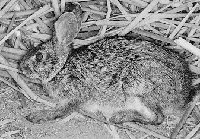<-back
Swamp Rabbit (Swamper)
Order Lagomorpha : Family Leporidae : Sylvilagus aquaticus
Description
Largest of the "cottontails" within its range; pelage coarse
and short for a rabbit; upper parts grayish brown, heavily lined
with blackish; rump, upper side of tail, and back of hind legs dull
ochraceous brown; sides of head and body paler than back, less suffused
with blackish; underparts, including underside of tail, white except
for buffy underside of neck; front legs and tops of hind feet cinnamon
rufous. External measurements average: total length, 534 mm; tail,
69 mm; hind foot, 106 mm; ear, 70 mm. Weight, 1.5-3 kg.
Habitat
Low, wet areas near rivers, streams, lakes, or ponds; hardwood bottomland
swamps, canebreaks, and thickets.
Behavior
These cottontails are generally solitary, coming together with conspecifics
primarily during the breeding season. Dominance hierarchies
exist among males; these determine mating priority. Vocal distress
calls consist of squeals and high-pitched squeaks. Swamp
Rabbits are seldom found far from water. They readily take
to water and swim well, often to escape predators. It is
active at dawn, dusk, or at night; during the day, it can be found
resting on a dry area that is surrounded by water. They probably
have two litters of four to six young per year; the breeding season
is from January to September.
Geographic Range
South-central United States
Females and males of this species are about the same size, which
is uncommon for this genus (females are usually larger). The pelage
is brown on top with some white underneath, especially on the underside
of the tail, which gives this genus the common name of cottontail.
Ears are of medium size, around 2.6 inches in length. Hair is short
and thin. Females have four or five pairs of mammae.
Food Habits
The diet of S. aquaticus consists of marsh and swamp plants
and reeds as well as cultivated plants. Two types of pellets are
formed--soft green ones and brown ones. The soft green pellets are
re-ingested to maximize the nutrients gained from food. Microorganisms
attach to these pellets in the gut and can increase the amount of
nutrients extracted the second time around.
Reproduction
During the breeding season, males fight to gain access to females
in estrous. Breeding in this species occurs almost year round.
After a gestation period of 40 days, between 1 and 6 young are
born. Birth occurs in nests made by the females. Nest holes for S.
aquaticus are on top of the ground and are made of dead vegetation
surrounding a fur inner lining. Young reach adult size by 30 weeks.
Economic Importance for Humans
Positive
Most cottontails are hunted for both meat and fur, and Swamper is
no exception. Hunting for sport purposes is also common.
Negative
The Swamper can damage crops and other vegetation important
to humans.
Conservation
This species is quite common, but future numbers may be threatened
by habitat destruction. In addition, excessive hunting has depleted
many populations.
Other Comments
To avoid predation, these rabbits flee in a zig-zag pattern. They
can reach speeds of up to 48 mph. They also are good swimmers,
and they are known to hide from enemies by lying motionless underwater
with only their nose clearing the surface of the water.



